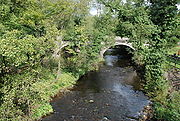
Calver
Encyclopedia

Village
A village is a clustered human settlement or community, larger than a hamlet with the population ranging from a few hundred to a few thousand , Though often located in rural areas, the term urban village is also applied to certain urban neighbourhoods, such as the West Village in Manhattan, New...
in Derbyshire
Derbyshire
Derbyshire is a county in the East Midlands of England. A substantial portion of the Peak District National Park lies within Derbyshire. The northern part of Derbyshire overlaps with the Pennines, a famous chain of hills and mountains. The county contains within its boundary of approx...
, England
England
England is a country that is part of the United Kingdom. It shares land borders with Scotland to the north and Wales to the west; the Irish Sea is to the north west, the Celtic Sea to the south west, with the North Sea to the east and the English Channel to the south separating it from continental...
.
Overview
Calver is a small village situated in the Derwent Valley, Derbyshire. The village is bordered by the River DerwentRiver Derwent, Derbyshire
The Derwent is a river in the county of Derbyshire, England. It is 66 miles long and is a tributary of the River Trent which it joins south of Derby. For half its course, the river flows through the Peak District....
and intersected by the A623 trunk road, responsible for carrying traffic between Manchester
Manchester
Manchester is a city and metropolitan borough in Greater Manchester, England. According to the Office for National Statistics, the 2010 mid-year population estimate for Manchester was 498,800. Manchester lies within one of the UK's largest metropolitan areas, the metropolitan county of Greater...
to the west, Sheffield
Sheffield
Sheffield is a city and metropolitan borough of South Yorkshire, England. Its name derives from the River Sheaf, which runs through the city. Historically a part of the West Riding of Yorkshire, and with some of its southern suburbs annexed from Derbyshire, the city has grown from its largely...
to the north & Chesterfield
Chesterfield
Chesterfield is a market town and a borough of Derbyshire, England. It lies north of Derby, on a confluence of the rivers Rother and Hipper. Its population is 70,260 , making it Derbyshire's largest town...
to the east.
Today, the village's buildings are predominantly residential, but some local enterprises, including a craft centre, garden centre, post office, petrol station and shop, garage, shoe shop, outdoor pursuits shop and two pubs remain. There are two camp sites in Calver and many walkers visit the area.
Historic mills
The village is the site of an historic cottonCotton
Cotton is a soft, fluffy staple fiber that grows in a boll, or protective capsule, around the seeds of cotton plants of the genus Gossypium. The fiber is almost pure cellulose. The botanical purpose of cotton fiber is to aid in seed dispersal....
mill opened in 1778 by John Gardom of Bakewell and John Pares of Leicester in place of a corn mill at leased from Thomas Eyre of Hassop.
By 1785, the mill had been developed and stood at three-storeys. In 1799, however, the River Derwent
River Derwent, Derbyshire
The Derwent is a river in the county of Derbyshire, England. It is 66 miles long and is a tributary of the River Trent which it joins south of Derby. For half its course, the river flows through the Peak District....
washed away Calver Bridge and took part of the mill with it; shortly after this event, the mill was burned to the ground. A new mill was subsequently constructed, and began production in 1804. By 1830 it employed 200 workers and in 1833 new, larger, water wheels were constructed.
Spinning finished in 1923, but during World War II
World War II
World War II, or the Second World War , was a global conflict lasting from 1939 to 1945, involving most of the world's nations—including all of the great powers—eventually forming two opposing military alliances: the Allies and the Axis...
the mill was used as a storage depot and as a plant for crushing and washing fluorspar used in steelmaking. In 1947 the mill was bought by W & G Sissons to produce stainless steel holloware.
The water wheels have disappeared, though their housings still exist and the building has been restored for use as apartments.
The village was also the home to an interesting corn mill, also confusingly called Calver Mill. It was constructed in the mid eighteen hundreds on the site of a smelting mill. The pitchback type wheel was about 5m in diameter and 1.7m in width. The millpond may have had various sources, including water in Calver sough extracted from the mine.
Media
The Mill was used as a set during production of the television series "Colditz Castle". It has since been converted into apartments.External links
- [www.pdmhs.com/.../Bulletin%2010-5%20-%20Calver%20Mill.pdf The Calver Mill (corn) survey 1989]

